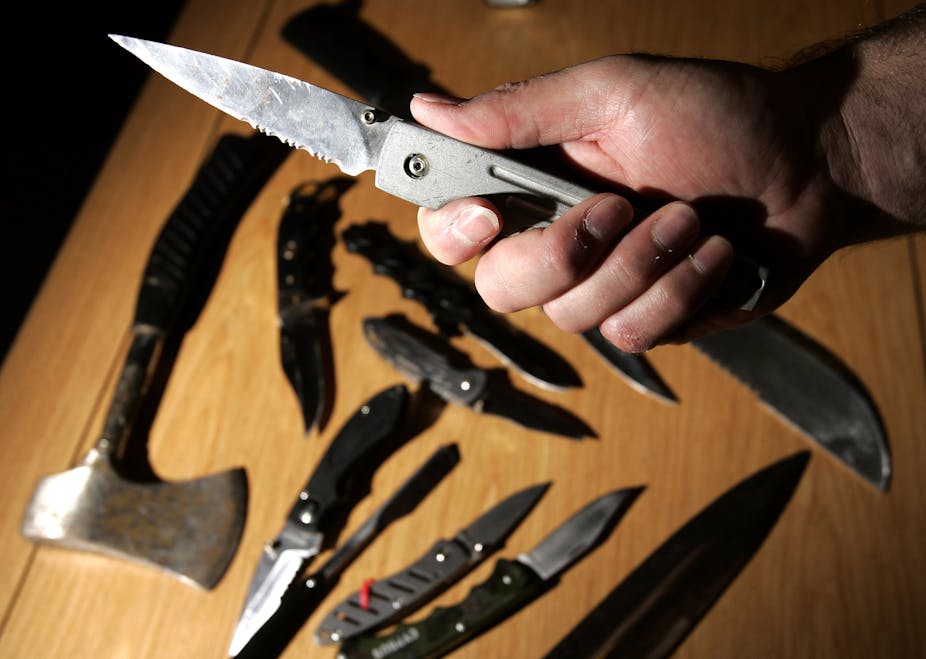Carrying a knife has become more common and more dangerous, according to newly released data. The number of people prosecuted for carrying a knife in the UK has gone up by 7% in the past year. There has also been a 15% rise in stabbings and knife attacks, with more than 13,000 incidents in the year to June 2015, while there have already been a third more knife-related murders in London this year compared to last.
Explanations for these increases include that numbers are approaching their average again, following years of historically low rates of knife-related crime and that the increase is a direct consequence of reduced use of stop and search by the police. Whatever the reason – and it is far too early to tell – one thing we can be certain of is the need to know more about why people carry and use weapons.
People who use knives are more likely to be male, young adults with a history of violence and substance misuse: the same factors that predict most other street violence. What sets weapon users apart from other violent offenders is the extreme nature of all these risk factors in their lives.
Studies from the North America and Europe have shown that weapon users are more aggressive, begin offending earlier, have more extensive histories of violent victimisation in childhood, make more risky decisions and are more likely to commit serious violence in the future than other violent offenders.
Armed and dangerous
Picking up a weapon is not a solitary decision: many weapon carriers are influenced by their peers and their communities. US research has found that if adolescents believe their peers carry weapons, they are more likely to carry a weapon themselves. An unfortunate further finding was that the more an adolescent carried a weapon, the more they believed that their friends carried weapons – even when this wasn’t true – so a feedback loop self-perpetuates the weapon carrying.
While this observation is unfortunate, it presents a valuable opportunity for intervention: if weapon carrying can be affected by perceived social norms, it’s possible these can be manipulated to reduce the number of people carrying weapons.
Community factors are also likely to play a role in determining who will carry a weapon – and what type. Irrespective of the amount of violence, the rate of legal firearm ownership in the US has been shown to predict the rate of illegal gun-carrying by adolescents in a community. Yet this phenomenon appears to be limited to the US. Switzerland has a rate of firearm homicide that is fifteen times less that of the US despite having a similar prevalence of household firearm ownership.
For someone who is planning or anticipating violence, using a weapon has many potential benefits. Weapon use increases the likelihood of successfully winning an altercation or completing a robbery – ironically, by avoiding violence. It also increases the pool of potential victims beyond those the person can overcome physically and allows several victims to be controlled simultaneously and from distance. For some career criminals, being known for gratuitous violence only enhances their reputation.
On the downside, victims are more likely to be injured or die. The right weapon for the job is not always available and some weapons, such as illegal guns are expensive and difficult to source. Victims are more likely to regard violence involving a weapon as a crime and to report it and – as any student of the Cold War will tell you – pulling a knife on someone today could result in their pulling a gun on you tomorrow.
Not just for self-defence
Beyond these simple “cost-benefit calculations”, we can be sure that the motivations for weapon use are complex. For example, despite weapons being valuable tools for perpetrating violence, the most commonly cited reason for carrying a weapon is self-defence. While this is possibly true in some cases, it doesn’t stand up to scrutiny.
Studies from the US have shown that substance misuse and a history of perpetrating violence are more likely to be the reason for somebody carrying a weapon than self-defence.
So we should ask why people feel the need to carry weapons for self-defence: don’t we have a police force to do this for us? Interviews with young offenders in the US found that many felt entitled to carry a weapon because of the disconnection they felt from “normal” society and the belief that the police could do nothing to keep them safe.
You’ll have noticed that much of the research we have on weapons comes from the US. But the high prevalence of firearm ownership and murder and the unusually lethal nature of guns makes the US a special case and limits the extent to which US research on weapon users can be generalised to the rest of the world. The motivations of those perpetrating weapon violence in countries with low prevalence of firearms may be entirely different. It is important that we explore these issues for ourselves so that we can reduce the number of young lives lost each year.

